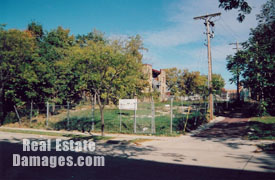Jeffrey Lyle Dahmer was arrested on July 22, 1991 for suspicion of murder. Dahmer stored and consumed his victim's remains within his apartment unit. He was subsequently convicted of murder and sent to prison, where he died in a prisoner attack. The 24-unit apartment where he had lived and committed his crimes was owned by a private party. After the discovery of his crimes, most of the renters in the other units quickly moved, and within a year, the vacancy within the apartment building rose to 83%. Although the owner realized the building had diminished in value, he did not want to demolish it, nor did he want to discount the apartment for liquidation. The apartment was located in a blighted urban area, where the crime rate was high and drug-houses and absentee landlords were common. These neighborhood conditions negatively impacted the nearby Marquette University, which had an enrollment of 10,000 students. In 1991, the neighborhood became part of a revitalization program under a non-profit organization called Campus Circle, which was in the start-up process at the time of Dahmer's arrest. Within one year of its inception, Campus Circle had acquired approximately 100 properties ranging from abandoned single-family residences to a 59-unit apartment building. By 1994, it had constructed a $35 million retail and residential development two blocks from the University, and a community-oriented police station was constructed on 21st Street. As a result of this redevelopment activity, the drug houses disappeared, crime dropped 44 percent, and the enrollment at the University increased notably. Despite the progress made in this redevelopment activity, the Dahmer apartment building was a daily reminder to the local residents and the University of the crimes that were committed there. As would be expected, its presence had a significant negative impact upon the Campus Circle project and the University. Many members of the community, including the victim's families and Campus Circle, desired to demolish the Dahmer apartment building and build a small playground, sometimes called a "tot-lot". According to the current owner, similar apartment buildings in the area had sold for $9,000 to $10,000. The former apartment building owner was aware of the surrounding redevelopment and the special motivations of Campus Circle. It was finally sold to Campus Circle on August 7, 1992 for $325,000, or $13,500 per unit. This was reportedly $3,000 to $4,000 per unit above market. This premium was paid due to their major financial investment in the neighborhood and school, as well as to address the desires of the victim's families. In November, 1992, the improvements were demolished. The planned "tot-lot" development had a cost of $150,000 and the City was to maintain the park; however, only $80,000 was successfully raised. Because of this shortfall, along with city budget cuts, the park was not completed and the site remains vacant. Current plans call for a community and children's garden in conjunction with a local grade and middle school. There are no plans for a memorial on the site. This situation is unusual and stands in contrast to most crime scene situations. Technically, the property sold for a premium; however, it was purchased in an effort to demolish the building and thereby enhance the neighborhood. In recognizing the high vacancy rate caused by the crimes and the special motivations of the buyer to acquire the property and promptly demolish it, it is apparent that the apartment building was negatively impacted by the crime scene stigma. In this instance, however, the property owner profited from the situation.
|
